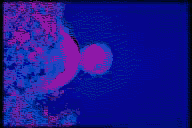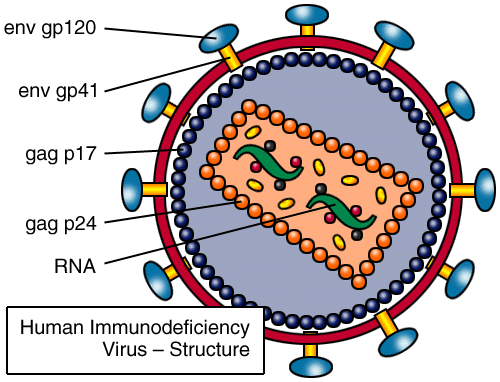
|
HIV Background and Structure |
|
This web page was produced as an assignment for an undergraduate course at Davidson College |
| Background |
| HIV belongs to a class of retroviruses that function by injecting the viral RNA into the host that express CD4; primarily CD4 T cells, dendritic cells, and macrophages (Gessani et al., 1997). The RNA is transcribed into DNA, and the viral DNA is inserted into a cellular chromosome of the host (Campbell, 1996). The RNA transcripts produced from the viral DNA function as mRNA to control the synthesis of new viruses and as the RNA genome carried by the virions (Janeway et al., 1999) Specifically, HIV belongs to a class of retroviruses known as lentiviruses, which are characterized by a long period of persistence and replication before any onset of disease (<www.aegis.com/topics/basics/hivandaids.html). |  |
| Figure 2- A scanning electron microscope image of an HIV virion attaching to a CD4 receptor of a T cell. This image is use with permission from mediamd.com <http://www.cmsp.com/data2/fx100004.htm>. |
| Structure |
 |
The viral envelope of HIV is composed of two layers of fatty molecules that are taken from an infected cell when the new virus buds off. Underneath the fatty molecules is a layer of matrix protein called p17. The HIV virion contains two important envelope proteins. Gp160 is a glycoprotein that is cleaved into gp120 and gp41, which are expressed as trimers to make up the viral envelope (Janeway et al. 1999). The gp120 moiety binds the virion and host via a CD4 receptor, whereas, gp41 is believed to induce fusion of the virus to the host cell membrane as well as anchor gp120 (Felser et al. 1988). On average 72 copies of the protein Env, containing three to four gp120 and three to four gp41 molecules, exist on the virus surface (Gelderblom et al., 1987 and Chan et al., 1998). |
| Figure 3- A structural image of the HIV molecule. Used with permission from <www.avert.org/virus.htm>. |
| The viral core of HIV is contained by 2000 copies of the viral protein, p24 (<www.aegis.com/topics/ basics/hivandaids.html>). This capsid holds 2 single strands of HIV RNA that encode for the virus' nine genes (see figure 4). HIV RNA contains long terminal repeats (LTR) which control the synthesis of new HIV viruses when activated by the host cell or HIV (Gelderblom et al., 1987) |
| Figure 4- Adapted from Janeway et al.(1999) |
| Gene | Gene Product and Function |
| gag (group-specific antigen) | Core proteins and matrix proteins |
| pol (polymerase) | reverse transcriptase, protease, and integrase enzymes |
| env (envelope) | transmembrane glycoproteins: gp120 binds to CD4 and CCR5; gp41 is required for virus internalization |
| tat (transactivator) | positive regulator of transcription |
| rev (regulator of viral expression) | allows export of unspliced transcripts from nucleus |
| vif (viral infectivity) | affects particle infectivity |
| vpr (viral protein R) | transport of DNA to nucleus, augments virion production, and controls cell cycle arrest |
| vpu (viral protein U) | unique to HIV-1; downregulates CD4 |
| nef (negative-regualtion factor) | augments viral replication in vivo and in vitro; downregulates CD4 |
| Home Page | Introduction | HIV Live Cycle |
| CD4 T Cells Role in HIV Infection | Treatment | References |
|
This web site was created for an Immunology class. Please direct correspondence to jodickens@davidson.edu. Last Updated April 21, 2000 |
|